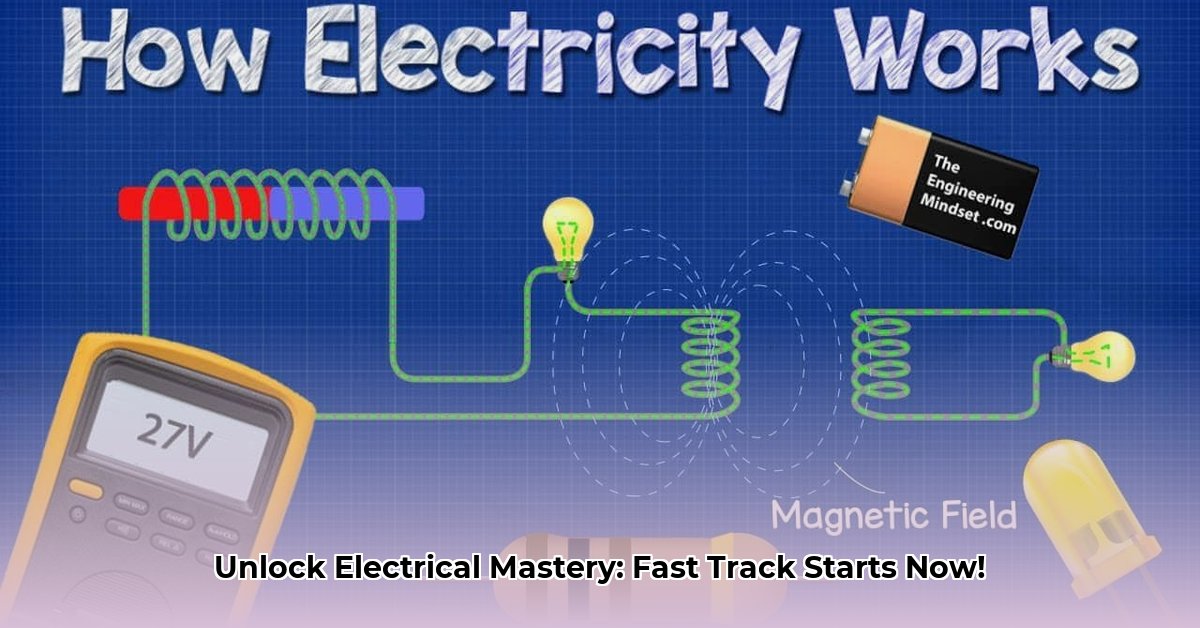
This beginner's guide provides a clear, step-by-step introduction to the fundamental principles of electricity. We'll use everyday analogies and simple examples to make understanding these core concepts easy and approachable. By the end, you'll have a solid grasp of voltage, current, resistance, Ohm's Law, and basic circuit analysis. For more in-depth learning, check out this advanced electrical theory guide.
Understanding Voltage, Current, and Resistance: The Electrical Power Trio
Think of electricity flowing like water in pipes. Voltage (V) is the electrical "pressure" – the force driving the flow of electricity. High voltage means a stronger push. We measure it in volts (V).
Current (I) represents the actual flow of electrical charge, much like the amount of water flowing through a pipe. It's measured in amperes, or amps (A). The higher the current (more flow), the more electricity is moving.
Finally, Resistance (R) is the opposition to the flow of electricity, similar to the narrowness of a pipe restricting water flow. A higher resistance means less electricity can flow. We measure it in ohms (Ω).
These three are interconnected by Ohm's Law, a cornerstone of electrical theory.
Ohm's Law: The Foundation of Electrical Circuits
Ohm's Law states: Voltage (V) = Current (I) x Resistance (R). This simple equation governs the relationship between voltage, current, and resistance in a circuit. Knowing any two of these values allows you to calculate the third. Did you know that 90% of basic circuit calculations rely on this single equation?
Example: A 12-volt battery (V=12V) is connected to a 3-ohm resistor (R=3Ω). The current (I) can be found using Ohm's Law: I = V/R = 12V / 3Ω = 4 amps.
Series and Parallel Circuits: Different Connections, Different Behaviors
Electrical components can be connected in two primary ways: series and parallel.
Series Circuits: In a series circuit, components are connected end-to-end, forming a single pathway for the current. If one component fails, the entire circuit is disrupted. The total resistance in a series circuit is the sum of individual resistances. Think of old-fashioned Christmas lights: one bulb burns out, and the whole string goes dark.
Parallel Circuits: In a parallel circuit, components are connected across each other, creating multiple pathways for the current. If one component fails, the others continue to function. The total resistance in a parallel circuit is less than the smallest individual resistance. Your home's electrical system is a classic example of a parallel circuit.
Understanding these circuit configurations is crucial for designing and troubleshooting electrical systems.
Kirchhoff's Laws: Analyzing Complex Circuits
As circuits become more complex, Ohm's Law alone isn't enough. Kirchhoff's Laws provide a systematic approach to analyzing intricate networks.
Kirchhoff's Current Law (KCL): At any point (node) in a circuit, the sum of currents entering equals the sum of currents leaving. It's like a water pipe junction: the flow in must equal the flow out.
Kirchhoff's Voltage Law (KVL): The sum of voltage drops around any closed loop in a circuit is zero. This reflects the conservation of energy. Imagine walking around a track—you end up back where you started with no net change in altitude.
These laws, alongside Ohm's Law, provide powerful tools for solving even the most complicated circuit problems.
AC vs. DC Circuits: The Current Difference
Electricity exists in two main forms: Direct Current (DC) and Alternating Current (AC).
DC: In a DC circuit, the current flows consistently in one direction, like a battery.
AC: In an AC circuit, the direction of current flow periodically reverses—typically 50 or 60 times per second in household circuits. This oscillation is what allows for efficient long-distance power transmission.
Understanding this difference is essential for working with various electrical systems. For example, household appliances primarily use AC, while many electronic devices use DC power provided by adapters that convert AC to DC.
Real-World Examples: Electricity in Everyday Life
Electricity powers nearly everything around us; from the lights in your home, to your phone charger, to the computer you're using. It is critical to always follow safety precautions, and never work with electricity if you are not appropriately trained.
Practice Problems
A 9-volt battery is connected to a 6-ohm resistor. What is the current? (Answer: 1.5 Amps)
Two 4-ohm resistors are connected in series. What's the total resistance? (Answer: 8 ohms)
This guide provides a strong foundation in electrical fundamentals. With this knowledge, you can begin to explore more advanced topics and the fascinating world of electrical engineering.
Key Takeaways
- Ohm's Law (V=IR): The fundamental relationship between voltage, current, and resistance.
- Kirchhoff's Laws: Essential tools for analyzing complex circuits.
- AC vs. DC: The key difference between alternating and direct current.
Remember to always prioritize safety when working with electricity!